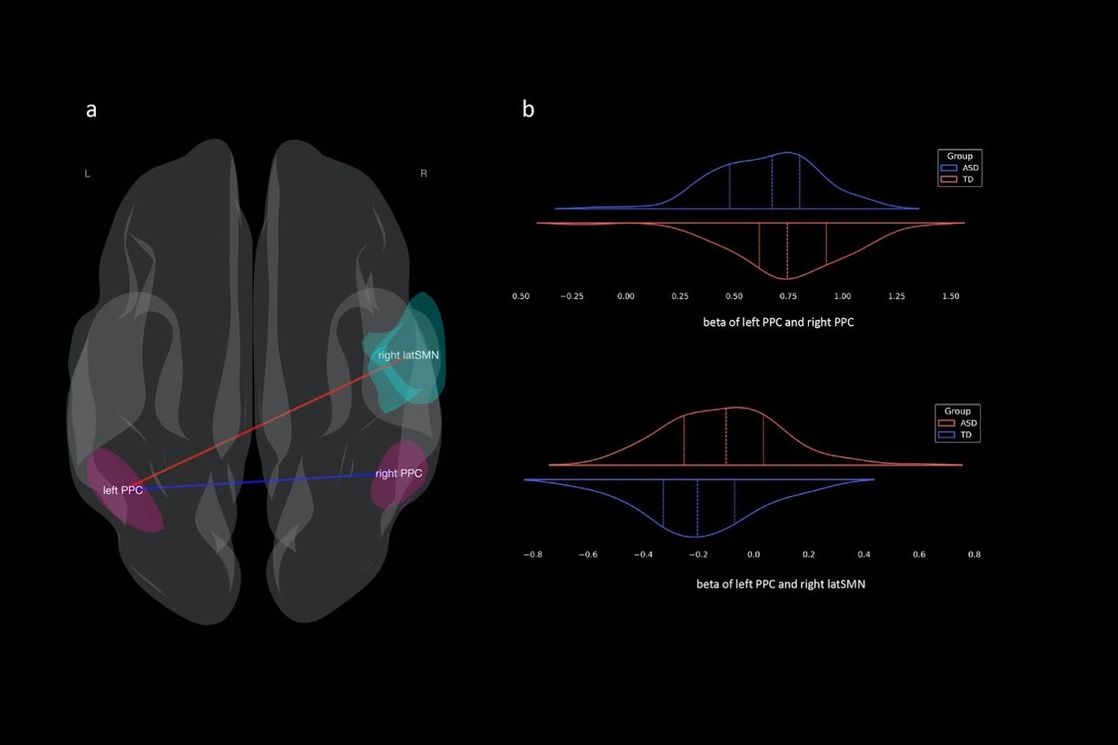HSE Scientists Reveal How Disrupted Brain Connectivity Affects Cognitive and Social Behaviour in Children with Autism

An international team of scientists, including researchers from the HSE Centre for Language and Brain, has for the first time studied the connectivity between the brain's sensorimotor and cognitive control networks in children with autism. Using fMRI data, the researchers found that connections within the cognitive control network (responsible for attention and inhibitory control) are weakened, while connections between this network and the sensorimotor network (responsible for movement and sensory processing) are, by contrast, excessively strong. These features manifest as difficulties in social interaction and behavioural regulation in children. The study has been published in Brain Imaging and Behavior.
For a person to focus attention, move, perceive others, and regulate their own behaviour at the same time, the brain engages multiple functional networks. Each network is responsible for a specific function: attention, movement, perception, or behavioural regulation. As individuals mature, the internal connections within these networks strengthen, while the connections between different networks, by contrast, tend to weaken. This allows the brain to allocate responsibilities across its systems, so they can operate independently without interfering with one another. This process is known as network segregation.
However, in autism spectrum disorders (ASD), network segregation may be disrupted. Autism spectrum disorders are neurodevelopmental conditions that alter the way individuals perceive information, interact with others, and respond to the world around them. To understand how disruptions in brain networks relate to these changes, researchers from the HSE Centre for Language and Brain, the Institute of Linguistics of the Russian Academy of Sciences, and the Seattle Children’s Research Institute studied, for the first time, the interaction between two key networks: the cognitive control network—responsible for attention, inhibitory control, and planning—and the sensorimotor network, which is involved in movement and sensory information processing.

The researchers analysed fMRI data from 121 children with ASD and 84 typically developing children, aged 5 to 14, and also administered four behavioural questionnaires to assess how the children interact with others, regulate their thoughts and actions, shift attention, and control their movements.
The study found that children with ASD have significantly weaker connections within the cognitive control network. The weaker the connections, the greater the difficulty the child experienced in regulating behaviour and shifting attention—findings that were also confirmed by the behavioural test results.
At the same time, the connections between the cognitive control network and the sensorimotor network were found to be excessively strong. This characteristic was associated with difficulties in social interaction and behaviour. However, neither stronger nor weaker connectivity affected the child’s ability to control their movements.

Alina Minnigulova
'In children with autism, the balance between autonomous functioning of networks and their interaction is disrupted. Rather than smooth internal coordination, excessive cross-activity occurs, hindering the brain’s ability to adapt when switching between external and internal signals,' explains Alina Minnigulova, Research Fellow at the HSE Centre for Language and Brain.
Importantly, these deviations are not only observable on fMRI but also correlate with specific manifestations of the disorder, such as communication difficulties, attention deficits, and problems with planning and task switching. These findings will advance our understanding of the neurophysiological mechanisms underlying ASD and may, in the future, support faster diagnosis of these conditions.
See also:
Internal Clock: How Heart Rate and Emotions Shape Our Perception of Time
Our perception of time depends on heart rate—this is the conclusion reached by neuroscientists at HSE University. In their experiment, volunteers watched short videos designed to evoke specific emotions and estimated each video's duration, while researchers recorded their heart activity using ECG. The study found that the slower a participant's heart rate, the shorter they perceived the video to be—especially when watching unpleasant content. The study has been published in Frontiers in Psychology.
Scientists Identify Personality Traits That Help Schoolchildren Succeed Academically
Economists from HSE University and the Southern Federal University have found that personality traits such as conscientiousness and open-mindedness help schoolchildren improve their academic performance. The study, conducted across seven countries, was the first large-scale international analysis of the impact of character traits on the academic achievement of 10 and 15-year-olds. The findings have been published in the International Journal of Educational Research.
Intellectual Capital in the Face of Shocks: Russia and Iran Explore Internationalisation
In today's issue of Schola, Mariya Molodchik, Senior Research Fellow at the International Laboratory of Intangible-Driven Economy and Professor at the School of Economics and Finance at HSE University’s Campus in Perm, discusses a joint project with Iran University of Science and Technology, titled 'Internationalization of Companies from Developing Countries: The Role of Intellectual Resources in Response to Exogenous Shocks.'
HSE Researchers Introduce Novel Symmetry-Aware Neural Network Architecture
Researchers at the HSE Laboratory for Geometric Algebra and Applications have developed a new neural network architecture that can accelerate and streamline data analysis in physics, biology, and engineering. The scientists presented their solution on July 16 in Vancouver at ICML 2025, one of the world's leading conferences on machine learning. Both the paper and the source code are publicly available.
Students from HSE and Other Universities Carry Out Research Expedition at New Chersonesos
As part of the Rediscovering Russia student expedition programme, HSE University organised a research trip under the framework of the School for Young Humanities Scholars to the New Chersonesos museum and church complex in Sevastopol. The results of this expedition will form the basis for proposals on educational projects aimed at shaping young people’s historical memory of the role of Chersonesos, Crimea, and the Byzantine legacy in the history of Russian culture and statehood.
HSE Researchers Determine Frequency of Genetic Mutations in People with Pulmonary Hypertension
For the first time in Russia, a team of scientists and clinicians has conducted a large-scale genetic study of patients with pulmonary arterial hypertension. The team, which included researchers from the International Laboratory of Bioinformatics at the HSE Faculty of Computer Science, analysed the genomes of over a hundred patients and found that approximately one in ten carried pathogenic mutations in the BMPR2 gene, which is responsible for vascular growth. Three of these mutations were described for the first time. The study has been published in Respiratory Research.
First Caucasus School on Experimental Research and Cognitive Sciences Takes Places in Adygea
On September 17–20, 2025, the First Caucasus School on Experimental Research and Cognitive Sciences took place at the Gornaya Legenda venue of Adyghe State University (ASU). The event was organised by the ASU Experimental Linguistics Laboratory, the HSE Centre for Language and Brain, and the HSE Centre for Sociocultural and Ethnolinguistic Studies. The school brought together over 50 participants—students, doctoral candidates, and early-career researchers from across Russia, along with lecturers and speakers from France, Serbia, China, Turkey, Kazakhstan, and Uzbekistan.
Similar Comprehension, Different Reading: How Native Language Affects Reading in English as a Second Language
Researchers from the MECO international project, including experts from the HSE Centre for Language and Brain, have developed a tool for analysing data on English text reading by native speakers of more than 19 languages. In a large-scale experiment involving over 1,200 people, researchers recorded participants’ eye movements as they silently read the same English texts and then assessed their level of comprehension. The results showed that even when comprehension levels were the same, the reading process—such as gaze fixations, rereading, and word skipping—varied depending on the reader's native language and their English proficiency. The study has been published in Studies in Second Language Acquisition.
‘The Future Is Not Predetermined—We Shape It with the Decisions We Make Today’
The strategic technological project ‘National Centre of Science, Technology, and Socio-Economic Foresight’ at HSE University spans horizons of 10 to 30 years and involves developing new methodologies of scenario analysis. It brings together researchers from different fields and helps to form a holistic vision of the future. The aim of the project is not only to produce forecasts but also to generate practical recommendations for government and business. Anastasia Likhacheva, Dean of the HSE Faculty of World Economy and International Affairs, explains why it is important to learn to ask the right questions about the future.
Mortgage and Demography: HSE Scientists Reveal How Mortgage Debt Shapes Family Priorities
Having a mortgage increases the likelihood that a Russian family will plan to have a child within the next three years by 39 percentage points. This is the conclusion of a study by Prof. Elena Vakulenko and doctoral student Rufina Evgrafova from the HSE Faculty of Economic Sciences. The authors emphasise that this effect is most pronounced among women, people under 36, and those without children. The study findings have been published in Voprosy Ekonomiki.


